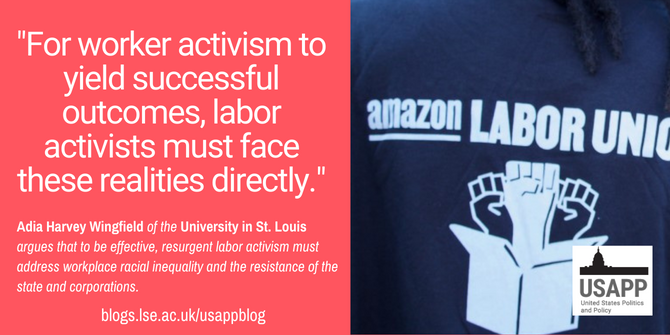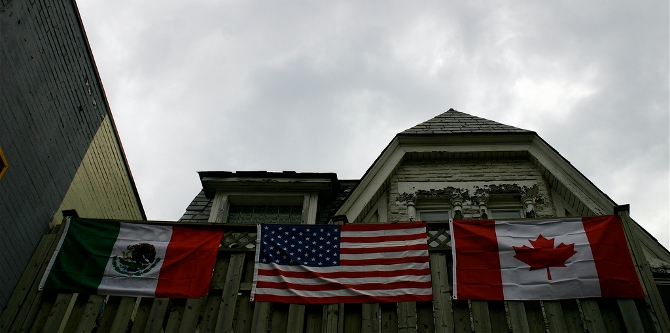 In recent years workers in large corporations such as Starbucks and Amazon have begun efforts to unionize to achieve better pay and conditions. Adia Wingfield argues that for workers’ union activism to be successful, it must consider the realities of racial discrimination in the workplace which see Black workers consistently underrepresented in high status, influential, prestigious occupations. Such movements, she writes, must also remember that efforts to make workplaces more racially equitable have historically been met with the leveraging of racist attitudes by anti-union business owners to curtail organizing efforts.
In recent years workers in large corporations such as Starbucks and Amazon have begun efforts to unionize to achieve better pay and conditions. Adia Wingfield argues that for workers’ union activism to be successful, it must consider the realities of racial discrimination in the workplace which see Black workers consistently underrepresented in high status, influential, prestigious occupations. Such movements, she writes, must also remember that efforts to make workplaces more racially equitable have historically been met with the leveraging of racist attitudes by anti-union business owners to curtail organizing efforts.
Union organizing and collective action in the workplace has a long history in the US, but much of that recent history has been marked by pronounced opposition as illustrated by recent corporate reactions to the attempts by workers of large corporations like Starbucks and Amazon to unionize. However, reporting from the Worker Empowerment Research Network (WERN) report reveals a recent surge of labor activism. The report identifies the growing number of workers who support not just collective bargaining, but also desire increased voice and representation in workplace matters and value organizational investment in labor market services, such as job training or retirement assistance.
These data indicate that labor activism is on the rise, with workers pursuing and supporting union membership and seeking out new ways to organize for different working conditions. But for these efforts to have a long-term impact, they must take two things into consideration: the importance of directly addressing sustained racial inequality in the workplace, and the history of state and private sector resistance to attempts to create racial equity in employment.
Racial Workplace Inequality
When it comes to racial inequality in the workplace, Black workers’ experiences provide an instructive case. These employees are consistently underrepresented in high status, influential, prestigious occupations. In the health care industry alone, Black workers represent a mere 5 percent of physicians, but 30 percent of home health care workers. They are also concentrated into jobs (transit work, food service) that tend to be lower status and less well-paid, but are a minimal presence of engineers, tech workers, financial service providers, and other occupational categories that have high status and reward highly skilled work.
Some of these differences are attributable to racial discrimination, particularly at the hiring stage. Harvard University Sociologist David Pedulla finds that racial stereotypes and assumptions about work ethic shape the ways hiring managers respond to Black employees’ applications. Furthermore, once hired, Black workers face exclusion from key social networks, harassment, and wage gaps.
For worker activism to yield successful outcomes, labor activists must face these realities directly. The WERN report finds that employees cite a voice gap in which they lack input into workplace procedures that affect them. Some of the areas where workers cite the largest gaps–abuse protections, antidiscrimination initiatives, and measures of respect towards employees—are sites that are likely to be fraught for Black workers. For the current wave of labor activism to last and make significant and meaningful change, it will have to address these and other racial disparities head-on. Doing so may mean organizing workers around categories related to identity, as the National Black Worker Center does. By highlighting racial disparities across a variety of industries and companies, organizations like this can keep the pressure on companies to address racial disparities and create more equitable opportunities for Black workers.

“Amazon Labor Union” (CC BY-NC 2.0) by pameladrew212
Anti-Worker Activism
But labor organizers must also remember that efforts to make workplaces more racially equitable have historically been met with vitriol and, in some cases, violence. The Knights of Labor, an organization comprised of both Black and white workers that advocated for equal pay, an eight-hour work week, and the elimination of child labor, was subjected to violent police attention and law enforcement crackdowns that eventually led to its demise in 1949. The Black Panther Party for Self Defense, which critiqued capitalism and demanded, among other things, “full employment for our people,” suffered sustained police harassment that escalated to the murder of leaders Fred Hampton and Mark Clark in 1969, and the imprisonment of other members including Assata Shakur, Geronimo Pratt, and Herman Bell. And it’s important to note that Dr. Martin Luther King Jr’s popularity tanked when he began to criticize not just racial segregation in the U.S., but American imperialism abroad and the ways racial inequality at home was bolstered by labor practices that kept Black workers impoverished.
Today’s organizers will not necessarily face such explicitly violent measures, but there are already some contemporary examples of how anti-union forces leverage racial stereotypes to undermine organizers’ efforts. In 2022 ex-Amazon worker Christian Small successfully managed, against enormous odds, to organize employees at his former plant. In response to his efforts, executives in a closed-door meeting derided him as “not smart or articulate” and pledged to make him “the face of the entire union/organizing movement.” Amazon leaders did not mean this as a compliment. Rather, they were drawing from long-held stereotypes of Black Americans as lazy, ignorant, and dumb. These depictions cast Black workers as people who do not belong in or qualify for leadership roles. In this case, Amazon’s characterizations did not deter Small’s fellow workers from unionizing, but their executives’ remarks are a disturbing reminder of how anti-union business owners can easily leverage racist attitudes to curtail organizing efforts.
A continuing fight to have a long-lasting impact
On their own, labor activists and organizers seeking racial equity often draw harsh responses. When these efforts are combined, and organizers attempt to push for better job conditions for Black workers or encourage multiracial groups to join forces to improve working conditions, history shows that the repercussions can be swift, harsh, and even deadly. If today’s labor organizers want to see their work have a long-lasting impact, it will be important not just to address persistent racial inequalities that exist in workplaces and labor markets. These activists must also be prepared to withstand opponents’ attempts to stoke racial divisions by inflaming stereotypes and biases, and if their campaigns are successful, they may need to be mindful of the fact that historically, winning concessions has bred enormous resistance.
- This article is based on the paper, ‘Race, Repression and the Future of New Labor Activism’, in Work and Occupations.
- Professor Wingfield’s new book, Gray Areas How the Way We Work Perpetuates Racism and What We Can Do to Fix will be published in October 2023.
- Please read our comments policy before commenting.
- Note: This article gives the views of the author, and not the position of USAPP – American Politics and Policy, nor the London School of Economics.
- Shortened URL for this post: https://bit.ly/3LCohKv






